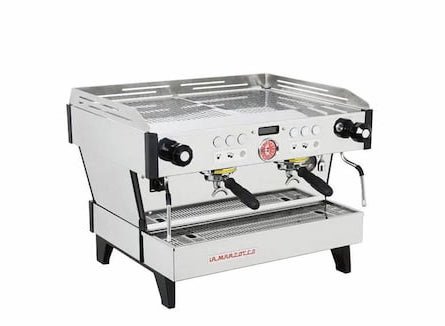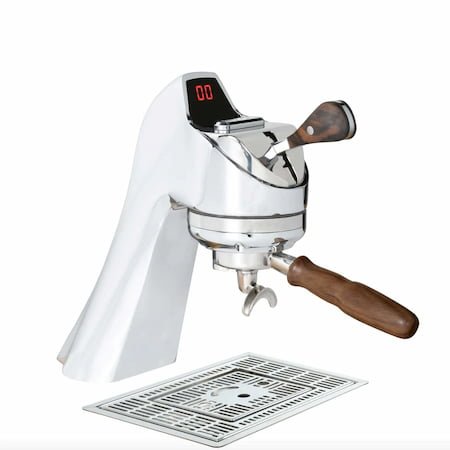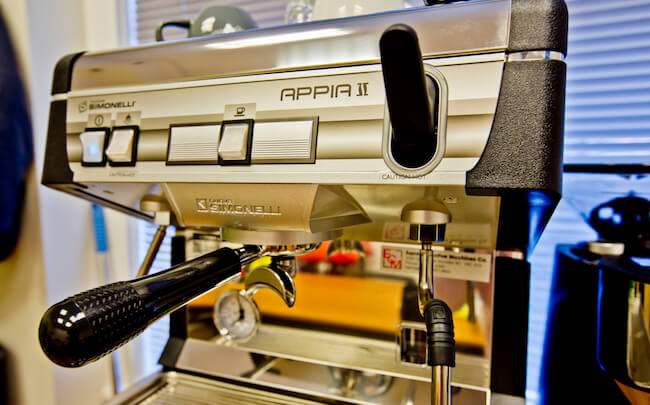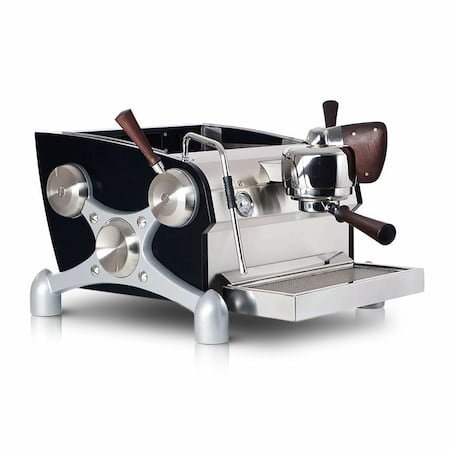A typical question from people who want to open a small coffee shop is whether a particular espresso machine would work out in a commercial setting.
The answer is almost always, ‘it depends, but probably not.’
If you anticipate anything beyond a minimal customer base, relying on a home-use espresso machine – even a high-end dual boiler – will eventually become a headache.
The demands of a coffee shop and of a home setting are just too different. So you need to start thinking like a professional.
In this article, we will explore the primary considerations if you want to run a thriving espresso bar.
Focus on the bottlenecks
The first thing you need is this: How many customers do you have in your busiest hour? And how many shots can your machine and grinder produce?
You need to treat is like a simple math question
Most likely you’ll have a massive influx of customers between 8 and 9 in the morning. So will you let them wait? If that’s the case, they might not be your customers for long.
The key takeaway here is that you shouldn’t focus on your customer volume per day but rather during peak hours.
The truth is, there’s a good reason we generally divide espresso machines into amateur and professional. It’s not that you can’t pull a great shot on that beautiful Rocket Giotto, it’s just that it’s made for a maximum of 15 shots per hour and not 100.
If you’re planning to run a larger café with more baristas working at the same time, you’ll probably want to consider a device with two brew heads.
One of the things that can bog down the whole process is if baristas have to wait for their turn.
Capacity of two groups
According to the Irish coffee guru and coffee shop owner Colin Harmon, more often than not, it’s the workflow and not the equipment that’s slowing you down.
In his book “What I know about running coffee shops” (which I recommend highly) he explains that a two-group machine can handle up to 125 drinks per hour and more often than not it’s just as good as a three-group:
“In my experience, the capacity of a two group machine in an eight-hour day is around 1,000 drinks with two baristas at a time (allowing for a third person relieving them for breaks) which equates to about 125 drinks an hour, or just shy of 20kg a day for those that are inclined to measure that way.”
According to Harmon, it’s hard to fit more than two baristas no matter how many groups you have. Unless you’re extremely busy two groups will probably suffice.
“I’ve seen a few cafés where they have an eight-group machine in place – something I’ve thought of as the monster-truck of our industry – but at peak times it still hard to get more than two people on that machine, and the amount of groups is rarely the limiting factor in a café’s production,” he writes in the book.
Features in a commercial espresso machine?
When we talk about home espresso machines, we frequently speak about fancy features. Well, the professional models also have exciting features, but usually, they are only secondary to the really big questions – like whether your model should be:
- Semiautomatic: you decide when the shot is finished
- Automatic volumetric: Cuts the shot automatically
- Manual lever: You actually ‘pull’ the shot by using the lever to force the water through.
If you are serious about your barista craft, you want to be able to customize the shot down to every little detail. That means you should go with the lever as that offers maximum control over extraction. It also looks pretty damn cool on those Instagram photos, which will be an essential part of your marketing.
Pros & cons
The downside is that it’s physically draining to pull a lever many times every day.
A semi gives you some control and saves you some work. It’s a decent compromise.
But let’s say you’re planning to be working at the café by yourself, and that you’re not that good at multitasking. You know, receiving orders and money, grinding, tamping, and steaming all that. In that case, you should consider a model that automatically stops brewing at the right time.
Remember to factor in the Grinder
You need more than a decent grinder for a high-volume coffee shop.
There’s this saying in specialty coffee that the grinder is more important than the espresso machine.
There’s a certain truth to that. Often the difference between a good shot and a fantastic shot is determined by the grinder.
One thing is certain, the grinder should be up to par when it comes to capacity.
Consider this scenario:
- You have an espresso machine that can handle 100 drinks an hour.
- But your grinder can only handle 50 drinks per hour.
In that case, the piece of equipment with the lowest capacity will become a bottleneck in your workflow.
There are some grinders out there that at first glance seem ‘pro.’ But that doesn’t mean that they can handle a considerable workload.
A model like the Baratza Sette is great for home use or for a handful of decaf shots a day in a small hipster café, but it won’t last long in a busy coffee shop.
On the other hand, there are some more grinders that on the surface seem more old-school, but are actually better suited for the life in a café due to solid construction and a workflow that makes sense in a coffee shop.
The top Commercial Espresso machines for every need
1: La Marzocco Linea PB

La Marzocco Linea PB is a high-quality espresso machine that has become an industry-standard in specialty coffee shops around the world. This top-of-the-line machine, designed by Piero Bambi, is known for its exceptional performance, reliability, and elegant design.
One of the key features of the Linea PB is its precise temperature stability, which ensures consistent extraction and optimal flavor in every espresso shot. The machine also offers dual boilers, allowing baristas to steam milk and pull shots simultaneously without compromising temperature or pressure.
Another significant advantage of the Linea PB is its durability. Constructed with high-quality stainless steel and built to withstand the demands of a busy café, this espresso machine is designed for long-term use.
Check Price2: Modbar

The Modbar Espresso System offers a unique and innovative approach to brewing espresso, combining under-counter design and advanced technology to deliver a clean and efficient coffee-making experience.
Compared to traditional espresso machines the minimal footprint of the espresso maker creates less of a barrier between the barista and the customers; it encourages engagement.
Developed as a collaboration between Modbar and La Marzocco, the Modbar boast impressive features that focus on precision, flavor, and consistency.
The Modbar System is developed to be a workhorse in a busy café environment and has a lot of helpful features such as volumetric or weight-based dosing.
The machine also has the same water temperature as the famous Linea PB, so you will always brew at the correct temperature.
Check the price3: La Pavoni Bar 3L-B Lever
La Pavoni is another old-school Italian coffee company. They are most famous for their small home espresso machines such as the Europiccola, but among espresso technicians, the commercial models are also praised for a great build.
This particular model has three levers. This means two things. First, it will look awesome in any café environment. Nothing exudes serious coffee like a lever machine. But secondly, it also means that you can control the extraction better.
The La Pavoni Bar 3L-B is built like a tank. It weighs in at roughly the same as a light-heavyweight boxer.
See more reviews4: Nuova Simonelli Appia II
The Nuova Simonelli Appia II is not the fanciest model on the market, but it is a workhorse of an espresso machine.
Known for its reliable performance, user-friendly design, and attractive appearance, the Appia II has become a popular choice among professionals in the coffee industry.
One of the main features of the Appia II is its consistent temperature stability, achieved through the use of a heat exchanger system. This ensures that the espresso extraction is always at the ideal temperature, providing rich flavors and excellent aroma.
Additionally, the machine’s Soft Infusion System (SIS) guarantees a smooth and balanced extraction, even when the coffee puck is unevenly tamped.
The Appia II is available in different configurations, including volumetric and semi-automatic models. The volumetric version enables baristas to program consistent water volumes for espresso shots, ensuring uniformity across all beverages.
See more reviews5: Slayer espresso
The Slayer Espresso machine is a modern classic. It even got a certain espresso style named after it; the so-called “Slayer shot”, which is based on an extra long preinfusion/pressure ramp-up.
Hailing from Seattle since 2007, the Slayer combines practicality, personal touch, and user-friendly features for both commercial environments – or home if you’re filthy rich.
Boasting a solid build quality and straightforward design, the Slayer lets you fine-tune your coffee game with its paddle design.
With its unique flow rate control and PID adjustable temperatures, the Slayer ensures perfect extraction while keeping the pump pressure steady.
Easy to use and maintain, this machine is a barista’s BFF when it comes to crafting amazing espresso experiences. The Slayer doesn’t just look good – it consistently delivers impressive results that outshine other machines in its league.
Check price




